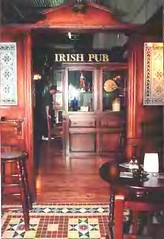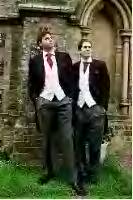Mallow Castle

Certain traditions ascribe the building of the original castle to King John or at least to his time. It seems certain that there was a very early Norman structure on the site, of what type would be impossible to say, but probably attributable to the Norman De Rupe or Roches who had displaced the native O'Keeffes from the district and driven them further west. A date is given for this early construction as 1185 A.D.
A new castle was built on the site in 1282 by the Desmond Fitzgeralds. Thomas Fitzmaurice, Baron of the Geraldines, exchanged a district in Connaught called Kerrylocknaun for "the Manor Moyale, Co. Cork, worth 70 marks", which apparently was the dower of Ellen, wife of Henry De Rupe, or Roche the Younger. No doubt its proximity to an important ford on the Blackwater, now covered by a bridge, influenced the exchange.
In 1286 Thomas got a grant to aid him in enclosing and keeping secure "his Vills of Tralee and Mallow". This Thomas died in 1298, but the property stayed secure in Geraldine hands until the Earl's uprising near the end of the 16th century at which time it belonged to Sir John of Desmond, brother of the Earl. They were the sons of James Fitzjohn. Sir John married Ellen, daughter of the 11th Earl of Muskerry, but the couple was childless. The pitiful remnant of what was once a powerful castle is south of the later Jacobean fortified house. It is merely a wall with a battered window and return angle walls - heavily battered at its base. The moat continues to the north of the gate under the mansion, which was obviously built over the site of the old castle. There are traces of what would have been curtain walls and there was a well between this wall and the castle.
In its days of grandeur the castle contained three courtyards, one of them being a forecourt or barbican, which had a thatch covered timber roof. During the Desmond uprising it fared badly being referred to in official documents as 'the ruinous house of Mallow'. Its owner, Sir John, described as a brave soldier, was killed while in captivity and his dismembered body hung from the gates of Cork. That was in 1581 and even before the rebellion was over the property was being parcelled out. In 1584, from a description of that time, the manor lands stretched north for about three miles, almost to Caherduggan, and south to the O'Callaghan castle of Dromore while it extended west, also towards O'Callaghan land, for about a mile and a half, and east for perhaps half a mile.
In the confiscations, Mallow was being set aside for Sir William Pelham, but Sir John Norreys, who had been appointed Lord President of Munster, succeeded in taking it over, saying that Mallow, in its strategic position in the middle of the county, should be allocated to him. Sir John died in 1587 and the property with the office passed to his brother, Sir Thomas Norreys, who had been Vice-President. Sir Thomas aided the Earl of Essex in his botched expedition of 1599 and received a fatal wound while, it is said, going to the Earl's aid at an affray in Kilkeelty, Co. Limerick, having marched there to oppose the Burkes. He had received a grant of the Seignory of Mallow, including an estate of 6,000 acres in 1596. While he was in office he had proposed to erect the now ruined fortified house and this was completed after his death.
The Norrey brothers came from Rycote in Oxfordshire, being two of the six sons of Lord Norreys of that place. Thomas's daughter, Elizabeth, was Godchild of Queen Elizabeth, after whom she was named. Up to a number of years ago the christening robe which she received as a present from Queen Elizabeth could be seen at the Castle. While still a minor, in 1607, she was married to Sir John Jephson, an army officer, and it is their descendants who, until recently, owned and lived in the castle property. They had four sons and four daughters. In 1615, on coming of age, she was presented, by a patent of James the First, with "The Castle and Town of Mallow and Short Castle, alias Castle Garr".
In 1636 Boyle, who by that time owned a considerable part of the rest of Munster, offered £15,000 for Mallow, but for once he was refused. During the Confederate War the family declared for the Parliament and Short Castle was taken by the Confederate forces under Viscount Mountgarrett. Much of the town was burned following their march to Mallow in February of 1642. The mansion house withstood this attack, being at that time under the command of Arthur Buttesworth, but in 1645 had to submit to Lord Castlehaven. The Parliamentarians recovered it in 1646 through Inchiquin.
Windele, the Cork historian of the last century, recounts a curious story in relation to the Castle and Jephson saying 'his love of pleasure was greater than his fortune' and he fell into debt. One night a gentleman appeared unannounced and, putting a large bag of gold on the table, asked Jephson if he would like to be free of debt. Jephson eagerly responded wherewith the gentleman produced a white rat and said that he could have the gold, provided that he agree to have the rat with him at all meal times, sitting on the chair to his right. Bemused, Jephson agreed and was the object of some merriment for years, until eventually, growing tired of the banter, the animal was excluded. After the guests had gone, the stranger was ushered into the room once again.
"Have you fulfilled your promise?"
"Yes until this night."
"The promise was forever," whereupon the stranger whisked up Sir John Jephson and flew with him out of the window. The white rat was, in after years, supposed to appear before the demise of the head of the family.
In another story it is said that the ghosts of Jephson and Miss Norreys walk on the avenue under the ruin in the evening. It is also said that lights are seen in the windows of the old castle. The mansion was then apparently still habitable although it had suffered damage. It was an oblong building with gables about 80ft. by 30ft. with small turrets at its corners for defence and with four sided projecting wings on the style of Monkstown or Mount Long. The entrance, with a semi-elliptical headed doorway, is in one of these and the other contained the stairs and garderobes. The windows were mullioned and have square heads with hoods. The floors, which were of timber, are gone so the building is a shell; which impression is helped by the fact that much of the inner furnishing was of timber as well. An extension at the southern end contained a kitchen area which abutted from the main building. The main part of the building is of red sandstone, with facings of cut limestone, much of which must have come from the old castle. There is little to aid defence apart from some slit windows in the towers.
The well-known clock in the Clock House, a few yards away from the castle, is said to have come from this mansion. A portion of the east wall fell down in 1836. After the failure at the Battle of the Boyne, MacDonogh MacCarthy moved from the Cork area with the apparent intention of taking the castle. Major-General Scavemore, who was approaching the town from the other direction, sent Colonel Dundas ahead to burn the bridge in an effort to stop the Jacobite advance. The Williamites then attacked the Irish Forces in the meadow near the bridge and defeated them. Just the same, the mansion was so badly damaged that when the Jephsons returned after the war they decided that the building was too far gone for repair so they settled in what had been the stables and eventually made them into the charming building which is called the modern Mallow Castle. While it had been intended to repair the building, this was never done.
The old mansion was made a National Monument in 1928. Commander Maurice Jephson has since disposed of the property, thus breaking a family link with Mallow which lasted almost four hundred years. The Castle was purchased by the McGinn family of Washington D.C. in 1984.



